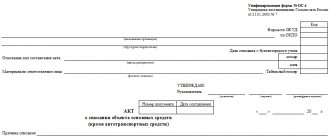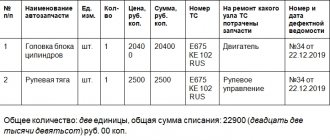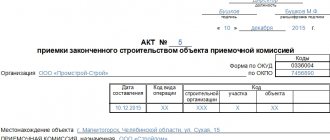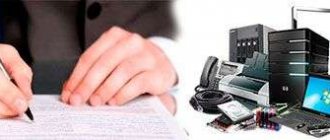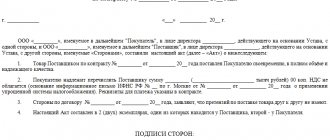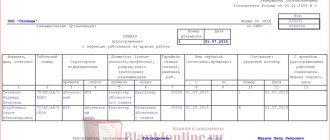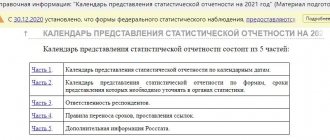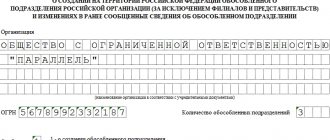Systematization of accounting
09/30/2018 Contents Equipment, buildings, structures, machines, equipment, vehicles and other property related to fixed assets can be written off from the balance sheets of enterprises, companies, organizations and institutions:
- in connection with the construction, expansion, reconstruction and technical re-equipment of enterprises, workshops or other facilities.
- that have become unusable due to physical wear and tear, accidents, natural disasters, violation of normal operating conditions and for other reasons;
- obsolete;
At the same time, property related to fixed assets is subject to write-off only in cases where it is impossible to restore it or is not economically feasible, and also when it cannot be sold or transferred to other organizations, institutions, companies, and enterprises. When decommissioning equipment at an enterprise, you should be guided, first of all, by the methodological instructions for accounting of fixed assets. Below we publish an extract from the guidelines for accounting of fixed assets, registered with the Ministry of Justice of the Russian Federation on November 21, 2003.
valid at the time of publication of the material on May 25, 2016. (You should check the official websites for changes and additions.) VI. Disposal of fixed assets 75. The cost of an item of fixed assets that is disposed of or is not constantly used for the production of products, performance of work and provision of services, or for the management needs of the organization, is subject to write-off from accounting.
76. The disposal of an item of fixed assets is recognized in the accounting records of the organization on the date of the one-time termination of the conditions for their acceptance for accounting given in “clause 2” of these Guidelines. Disposal of an item of fixed assets may occur in the following cases:
- transfers in the form of a contribution to the authorized (share) capital of other organizations, a mutual fund;
- liquidation in case of accidents, natural disasters and other emergency situations;
- sales;
- write-offs in case of moral and physical wear and tear;
Free legal advice online
The involvement of lawyers in legal disputes is due to the need to fully protect the personal interests of citizens. As practice shows, citizens avoid legal assistance in order to save money, but in practice this is associated with high costs.
Even citizens with a lawyer's education do not always keep up with current changes in legislation, so it would be advisable to consult a qualified specialist.
The convenience is that consultation with a lawyer is free and online.
Where and how to get free legal advice? is provided throughout the Russian Federation. Citizens, residents of the state, as well as non-residents of the country who temporarily reside in the Russian Federation can take advantage of the support.
Moreover, lawyers can advise interested parties outside Russia, but only within the framework of domestic legislation. Legal advice is provided free of charge online around the clock, regardless of weekends and holidays. The response time from specialists on the website is up to 15 minutes.
There is no need to register on the Internet portal and you can send a personal appeal anonymously. Attention! The online lawyer provides answers to questions and continues to support the client in the event of further difficulties. Legal advice can be obtained in the following ways:
- use the online chat service;
- call the hotline.
- draw up a contact form for the feedback service;
Online legal consultation can also be carried out via email.
The advantages of the services of our law firm are due to the professional attitude of our specialists to their work, the receipt of regular training courses, as well as participation in official forums.
This ensures that individuals and businesses can receive advice that complies with current legal provisions.
Certificates are provided
Certificate of write-off of equipment that has become unusable
Using this link you can download “” for free in doc format, 12.0 KB in size. All organizations are faced with the need to write off old equipment.
Computers, office equipment and other property must be disposed of according to a write-off report. Correct write-off requires an expert opinion on the condition of the equipment, which contains an assessment confirming the impossibility of further use. A specially created commission or an invited expert organization draws up a technical inspection report, on the basis of which it is possible to write off fixed assets from the balance sheet and dispose of them.
Property tax has to be paid for equipment that has not been written off but is out of order or obsolete. You can write off fixed assets gradually - through depreciation, but there is a shorter way - drawing up an equipment write-off act. It is recommended to write off material assets that:
- obsolete;
- extremely worn out;
- damaged when repair is impossible or economically unfeasible.
- do not exist based on inventory results;
- cannot be used because they have become unusable;
Every year, the head of the organization must issue an order appointing a commission to write off fixed assets.
The chairman of such a commission is, as a rule, a deputy director, and the members of the commission are the chief accountant, economists and engineers.
In most cases, fixed assets are subject to write-off in the following cases:
- It is impossible or economically infeasible to restore the object.
- The property fell into disrepair.
- Equipment does not exist as a single entity.
All three circumstances must be present, otherwise the write-off will be illegal.
For example, you cannot write off a computer on the grounds that its performance is not sufficient to run a program. The hardware remains suitable for lower performance programs such as word processing or email.
How to write off a set of tools reasons
Equipment write-off act is a document that is drawn up by several persons and confirms the fact that the equipment has been written off.
All organizations are faced with the need to write off old equipment. Computers, office equipment and other property must be disposed of according to a write-off report.
Correct write-off requires an expert opinion on the condition of the equipment, which contains an assessment confirming the impossibility of further use.
A specially created commission or an invited expert organization draws up a technical inspection report, on the basis of which it is possible to write off fixed assets from the balance sheet and dispose of them.
Property tax has to be paid for equipment that has not been written off but is out of order or obsolete. You can write off fixed assets gradually - through depreciation, but there is a shorter way - drawing up an equipment write-off act. It is recommended to write off material assets that:
- cannot be used because they have become unusable;
- do not exist based on inventory results;
- damaged when repair is impossible or economically unfeasible.
Every year, the head of the organization must issue an order appointing a commission to write off fixed assets. The chairman of such a commission is, as a rule, a deputy director, and the members of the commission are the chief accountant, economists and engineers.
Reasons for decommissioning equipment
In most cases, fixed assets are subject to write-off in the following cases:
— The property has fallen into disrepair.
— It is impossible or economically infeasible to restore the object.
— Equipment does not exist as a single object.
All three circumstances must be present, otherwise the write-off will be illegal.
For example, you cannot write off a computer on the grounds that its performance is not sufficient to run a program.
The hardware remains suitable for lower performance programs such as word processing or email.
The write-off of the printer will be considered unreasonable if the commission does not include a technical specialist who can confirm that the fixed asset cannot be repaired. It will also not be legal to write off equipment without a decision on its disposal.
If the organization does not have a technical service that can competently confirm the impossibility of restoring equipment, you should contact third-party specialists.
The list of activities of the invited organization must include an examination of the technical condition of equipment, a documented level of qualifications of specialists for conducting diagnostics of the relevant fixed assets.
An agreement is concluded with the selected organization with the wording “Diagnostics of equipment to estimate repair costs.” If the certificate of completion of work issued by the invited organization contains a conclusion about the malfunction and impossibility of restoring the equipment, the organization that owns the fixed assets will receive sufficient grounds for write-off.
To make an informed decision about the feasibility of restoring equipment, you should:
— compare the cost of repairs with the price of new equipment;
— assess the consequences taking into account the duration of the repair;
— compare the warranty period of new and repaired equipment.
When making a decision to dispose of equipment, an appropriate act must be drawn up with photographic materials documenting the disassembled (destroyed) object.
An alternative way to write off the cost of special tools
The photographs must show the brand and serial number of the equipment.
General principles for drawing up a write-off act
Drawing up a write-off act is mandatory in office work. The fact is that each item on the balance sheet has its own value, which is indicated in the relevant accounting documents.
This means, sooner or later, there will be a need to present this item, be it to tax authorities or business buyers. And in case of its absence, documents confirming its write-off are presented.
Hence the importance of its correct preparation. The first thing to note is that, like any audit act, it has the right to be drawn up by a commission.
Its members should include:
— Heads of departments in whose department the value is located.
— Competent engineering staff.
— An accountant may be present.
“And it certainly wouldn’t hurt to have a lawyer involved.”
The act must indicate all identifying information about the value being written off.
This data may include:
— Distinctive technical characteristics.
In addition, it is necessary to clearly formulate the reason for the write-off. This reason will later become the basis. In case of write-off due to breakdown, damage received, etc., it is necessary to obtain a technical examination report before write-off. This act, in turn, will become the basis for write-off.
Structure of the write-off act
The write-off act has a header that includes the name of the document, city and date of preparation. The body of the act indicates all the data that was specified in the previous section.
After the descriptive part comes the part with the reasons. It refers to the grounds that give the right to decide on the impossibility of using the value in the future.
At the end of the body of the act, the commission makes a decision on write-off, taking into account all the grounds.
After the decision is made, all members of the commission are indicated at the end of the text. The act is signed and sent to an accountant for processing.
Sample equipment decommissioning certificate
Head of the institution _________________
(title, surname)
“__” ________________ 20__
Act of write-off of furniture, inventory, equipment and household items
from _____________ 20__
Commission consisting of: _____________________________________________,
acting on the basis of order ________________________________,
examined __________________________________________________________ (name of items)
and found them to be written off based on the following:
No. — Name of items subject to write-off — Unit of measurement — Quantity — Period established by order — Time of receipt in service
Technical condition and reasons for write-off________________________________________________________________________________________________________________________________________________ Conclusion of the commission _______________________________________________
__________________________________________________________________
Chairman of the commission _______________________
Members of the commission: _______________________ _______________________
_______________________
Conclusion of the commission in the act of acceptance of the transfer of fixed assets
The act is endorsed by the head of the tool or planning department and submitted to the central tool warehouse (CIS), which issues tools (devices) to the workshop of the same name, brand and size according to the act without issuing requirements and limit cards.
After the warehouse issues the tools (devices), the act is transferred to the accounting department, where, according to these acts, the tools (devices) are written off from the warehouse, without reflecting their movement through the dispensing storerooms of the workshops.
Tools (devices) issued by the warehouse in the order of exchange according to acts are not reflected in the registration cards of distribution pantries.
[3] It is used to formalize the write-off of tools (devices) that have become unusable and exchange them for suitable ones at those enterprises where accounting is carried out using the exchange (working) fund method. According to the act, the unusable instrument is handed over to the storage room for scrap.
How to draw up an act for writing off materials
At his request, they collect a commission or simply attract an accounting employee to participate in the process of inventorying material assets to be written off. There is no single form of document established by law; the act is drawn up in any form, but there are also mandatory requirements for its content.
It should reflect:
- Name of the enterprise and date of registration, order number.
- Commission members participating in the write-off: their names and positions.
- List of materials to be written off: number of units or weight of each item with an indication of cost.
- Totals: total quantity and amount.
- Description of the causes of defects or damage.
- Signatures of persons participating in the process, including the financially responsible employee.
Source: https://si-center.ru/info/kak-spisat-nabor-instrumentov-prichiny/
Certificate of write-off of a tool that has become unusable
Copyright: Lori's photo bank Tools and equipment used in the enterprise become unusable over time.
If they cannot be restored and cannot be used in the future, they must be excluded from the organization’s property by writing off. This operation must be properly documented. The write-off of an instrument that has become unusable takes place in a strictly established manner and must be documented in an act (clause
56 Guidelines for accounting of special tools, approved. Order of the Ministry of Finance of the Russian Federation dated December 26, 2002 No. 135n). This document confirms the fact of write-off and reflects the main reasons for its publication.
A well-drafted act will ensure the reliability of accounting, and regular write-off of worn-out instruments will reduce the tax burden on the organization.
Features of drawing up an act for writing off an instrument
The act can be drawn up on a sheet of A4 paper or on the organization’s letterhead. In most cases, it is compiled in one copy, which is then transferred to the accounting department. If necessary, additional copies can be made. Since this document relates to the internal document flow of the organization, there is no need to certify it with a seal. But it will require recording in a special journal.
The act of writing off an instrument that has become unusable must contain:
- name of the legal entity;
- FULL NAME. and the signature of the manager under the heading “I approve”;
- information about the members of the commission (positions, full names);
- a detailed list of instruments to be written off;
- quantity and cost of tools;
- reason for write-off.
The composition of the commission is determined by a separate order of the director of the enterprise. When the act of writing off the instruments is drawn up, all members of the commission must sign it. This confirms that the information entered is correct. After completing the procedure, the document must be approved by the head of the enterprise. An approximate act for writing off a tool that has become unusable (sample) can be found below.
Reasons and grounds for writing off material assets
- /
- /
October 3, 2021 0 Rating Share We recommend a selection The reasons for writing off material assets can be varied: from identified defects to obsolescence. Find out more in our material about the reasons and grounds for writing off valuables. Material assets are subject to write-off if they:
- Consumed during the normal production process in the manufacture of final products or semi-finished products.
- They have lost their original properties and cannot be used for their intended purpose.
In the first case, for the write-off of each batch of raw materials and materials, there is no need for a special written permission from management - the write-off is carried out according to established standards, which must be justified and approved by the head of the enterprise.
We recommend reading: Power of attorney to represent the interests of an individual docx
The write-off process has its own characteristics, which will be discussed in one of the subsequent sections.
In the second case, writing off valuables requires an individual approach, and in each case, writing off is carried out on commission. Methods for writing off material assets should be reflected in the accounting policies of the enterprise. Detailed write-off processes (templates for documents for write-off, regulations for their execution and reflection on accounting accounts, other aspects) are prescribed in the internal regulations of the enterprise (Regulations on accounting and write-off of valuables, orders, instructions, instructions).
Thus, even before the start of writing off assets, the enterprise needs to regulate this process (develop internal regulations and instructions) and consolidate important accounting aspects in the accounting policy.
Writing off valuables during the production process is a natural process. It is impossible to make a product without using up certain materials.
It does not matter what type of final product is manufactured - write-off of raw materials is inevitable. Its quantity and types depend on the complexity and composition of the final product.
When is it necessary to draw up a write-off act for material assets?
Before starting to write off material assets that have failed, company management needs to carry out an inventory procedure. Carrying out such a procedure allows us to identify all damaged objects, expired raw materials and assets with defects. All damaged objects must be transferred to a warehouse for their further disposal. During this process, a demand invoice is issued.
It is important to note that company management can create either a temporary or permanent commission. It should include representatives from different departments. In the case where the object of write-off is production equipment, the commission includes a specialized employee. The procedure under consideration requires the mandatory participation of an accountant, since all material assets are under his control. In addition, the inventory commission may include representatives from a trade union organization.
Any production process is accompanied by the acquisition, storage and use of material assets, which include tools
Members of this commission are required to carefully examine all assets owned by the company. During this process, the technical characteristics of the objects and their equipment are studied. One of the main tasks of the commission is to determine the reasons for the failure of a particular asset. Based on all of the above measures, an act is drawn up allowing the object to be written off. This act contains not only the reasons for the breakdown of instruments, but the grounds for write-off. This document should reflect the number of objects being written off and their detailed description. Properly drawn up acts are the key to reliable accounting. Regular holding of such events allows the company to significantly reduce the tax burden on the business.
Many accounting professionals recommend taking inventory at least once a month. It is also possible to conduct an audit before the end of the reporting period. This approach allows you to identify objects that cannot be used in the next production cycle. When filling out the report, it is very important to display all the factors contributing to equipment failure. In the case where the breakdown is caused by external factors, it is necessary to reflect all the circumstances of this process.
Certificate of write-off of a tool that has become unusable
If the write-off process continues for several days, for example, an inventory of property is being carried out, then you need to indicate in the act the time period of the entire process. Document title Can have two forms - “Writ-off act ...” or “Writ-off act ...”, any of the options is correct Text part Begins indicating the basis for creation. Since in most cases this is an order from the manager, this is how it is written “Based on the order...”.
The exact details of the administrative document must be indicated. Approval stamp by the manager. Placed in the upper right part of the form.
For the write-off procedure, interested parties are invited: this may be the immediate manager of the enterprise, an accounting employee, a storekeeper or another person responsible for storage and sales. The chief engineer may be invited if obsolete or defective equipment is being written off. All of the above members of the commission are personally present when the act is drawn up and seal it with their signatures. Attention: The document is approved by management and transferred to the accounting department for further accounting actions.
ImportantFor current repairs To confirm the validity of writing off materials for current repairs, an inspection report of the premises to be repaired is drawn up, indicating the indications. The list of upcoming work is approved by the manager.
Based on the estimate, an act of writing off materials for current repairs is drawn up. The act displays the actual materials consumed, indicating their cost and acquisition costs.
Example of filling out The form of the act for write-off of materials is arbitrary. But the document should be drawn up in such a way that no additional questions arise regarding the reasons and grounds for write-off.
The inventory results, prepared accordingly, will confirm the fact of a shortage of property. In addition, you need to contact the internal affairs authorities with a statement of theft. If this is not done, then the organization will not be able to reduce the income tax base on the value of stolen assets. It is possible to prove with documents that the thieves have not been found only with a copy of the decision of the investigator or inquiry officer to suspend the criminal case on the basis of subparagraph 1 of paragraph 1 of Article 208 of the Criminal Code. procedural code of the Russian Federation.
Documents found on the topic “Instrument write-off certificate sample”
- Sample . An act for writing off tools (devices) and exchanging them for suitable ones.
Form No. MB-5 Accounting statements, accounting → Sample. An act for writing off tools (devices) and exchanging them for suitable ones. Form No. MB-5 ...approved by the Decree of the State Statistics Committee of the USSR dated December 28, 1989 no. 241 +-+ (enterprise, organization) okud code +-+ the act for writing off tools (devices) and exchanging them for suitable ones (position) (signature) (f., f., surname) ... - Sample. Act on write-off damaged work record forms
Accounting statements, accounting → Sample. Act on writing off damaged work record formsm.p. I approve to the head of the enterprise (signature, surname and initials) an act for writing off damaged forms of work books of the year "" 20 by us (positions, initials and surnames of members are listed ...
- Sample. Act on write-off low-value and high-wear items. Form No. MB-8
Accounting statements, accounting → Sample. Act on write-off of low-value and high-wear items. Form No. MB-8...acceptance, organization) code by okud +-+ approve (position) (signature) (and., o., surname) "" 20 year act on write-off of low-value and wearable items commission appointed by order dated "" 20 no . , examined the p...
- Sample. Act on write-off fixed assets. Form No. os-3 (Resolution of the USSR State Statistics Committee dated December 28, 1989 No. 241)
Accounting statements, accounting → Sample. Act on write-off of fixed assets. Form No. os-3 (Resolution of the USSR State Statistics Committee dated December 28, 1989 No. 241)... code for okud (enterprise, organization) +-+ approved by the head of the enterprise (signature) (full name) "" 20 act +-+ for write-off of fixed assets number date code of the type of document for drawing up the transaction +- +-+- +-+ +-+ debit credit...
- Act on write-off technical means
Accounting statements, accounting → Certificate of write-off of technical equipmentact on write-off of technical equipment I approve "" 20 year act on write-off (type of equipment) "" 20 year to...
- Act on write-off technical means
Accounting statements, accounting → Certificate of write-off of technical equipmentact on write-off of technical equipment I approve "" 20 year act on write-off (type of equipment) "" 20 year to...
- Act write-offs motor resources
Documents of the enterprise's office work → Certificate of write-off of motor resources... State Customs Code of the Russian Federation dated 02.10.96 no. 609 I approve the head (name of department) (surname and initials) “” 20, act no. write-off of motor resources commission consisting of: chairman (position, surname and , members of the commission initials)…
- Act O write-off materials for current repairs
Accounting and financial documents → Certificate of write-off of materials for current repairs... "" 20, act on the write-off of materials for current repairs No. dated "" 20, a commission consisting of: chairman and members ...
- Act O write-off vehicles (Unified form N OS-4a)
Enterprise records management documents → Certificate of write-off of motor vehicles (Unified Form N OS-4a)The document “ Act on write-off of motor vehicles (unified form n OS-4a)” in excel format can be obtained from the link “sk...
- Act on write-off low-value and wearable items (Standard interindustry form N MB-8)
Enterprise records management documents → Act on write-off of low-value and wear-and-tear items (Standard interindustry form N MB-8)document “ Act for write-off of low-value and wear-and-tear items (standard interindustry form n mb-8)” in excel format you can...
- Form No. MB-8 Act on write-off low-value and wearable items
Accounting statements, accounting → Form No. MB-8 act on write-off of low-value and wear-and-tear itemsact on write-off of low-value and wear-and-tear items form no. MB-8 (front side) standard interdepartmental...
- Act O write-off goods (Unified form N TORG-16)
Enterprise records management documents → Certificate of write-off of goods (Unified form N TORG-16)The document “Weight sheet (Unified form N MX-9)” in Excel format can be obtained from the link “Download
- Act on write-off low-value and high-wear items. Form No. MB-8
Accounting statements, accounting → Act on write-off of low-value and wear-and-tear items. Form No. MB-8…G. no. 1148 +-+ Okud code 0311008 3 +-+ I approve: (position) (signature) (full name) “” 20 +-+ act no. +-+ for writing off low-value and wear-and-tear items “” 20g. commission appointed by order no. from "" 20 ...
- Sample. Order for repair or sharpening tools (devices). Form No. MB-3
Enterprise records management documents → Sample. Order for repair or sharpening of tools (devices). Form No. MB-3...comstat of the USSR dated December 28, 1989 no. 241 +-+ (enterprise, organization) code by okud +-+ order for repair or sharpening of tools (devices) +-+ number date workshop corresponding invoice document deadline composition-+-+-execution order-execution-account...
- Sample. Statement for replenishment (withdrawal) of permanent stock tools (devices). Form No. MB-1
Accounting statements, accounting → Sample. Statement for replenishment (withdrawal) of a permanent stock of tools (devices). Form No. MB-1…12.89 no. 241 +-+ (enterprise, organization) code for payroll +-+ statement of replenishment for - permanent stock of tools withdrawal (devices) +-+ number date code corresponding account document- sos- +-+- tav- type sent- ...
Certificate of write-off of a tool that has become unusable
› › › Any production process is accompanied by the acquisition, storage and use of material assets, which include tools. After completing the service life established by the manufacturer, they lose their functionality. Due to the active use of equipment to ensure production of products, premature wear is possible.
Disposal of unusable instrumentsAccidents and natural disasters can also cause equipment to become dilapidated or unsuitable for further use.
If the instrument cannot be restored, then its further storage and recording on the balance sheet is meaningless, which should be the reason for initiating an action to write off the object. It must be properly documented and executed.
All material assets of a business entity are taken into account in its financial documentation.
Therefore, it is impossible to simply throw away an item that is unusable.
At the very first inventory of valuables, a shortage will be identified, and the chief accountant will be presented with claims about the unreliability of accounting. Instruments that have become unusable must be removed from the register by writing off. The procedure is regulated by the norms of legal sources.
Its competent implementation makes it possible to eliminate inconsistencies in various reporting forms. In order to prevent theft of the enterprise’s property, to implement the write-off procedure it is necessary to involve a group of specialists assigned to the commission by administrative documentation. It is formed from the chairman of the commission and its members. Representatives of the organization document the fact that it is impossible to further operate the tools due to their damage, as well as the amount of equipment that is subject to write-off. A mandatory element of the write-off procedure is the drawing up of an appropriate act indicating the fact of the event and the justified reasons for its initiation.
Accounting
The procedure for writing off goods subject to disposal will depend on the reasons as a result of which it was damaged or became unsuitable for use.
However, in any case, the cost of such goods is reflected as their shortage in the debit of account 94 “Shortages and losses from damage to valuables” (Instructions for the application of the Chart of Accounts for accounting financial and economic activities of organizations, approved by Order of the Ministry of Finance of Russia dated October 31, 2000 No. 94n).
If it is determined that the storage conditions of the goods were violated, its damage shall be attributed to the person at fault.
In such a situation, the amount of the shortfall in the part reimbursed by the employee is written off to account 73–2 “Calculations for compensation for material damage.”
If a product has become unsuitable for use as a result of the expiration of its shelf life, then its cost is written off as expenses in the debit of account 91-2 “Other expenses”.
The accounting records of a trading company will look like this:
| Contents of operation | Debit | Credit |
| The cost of damaged (overdue) goods has been written off | 94 | 41 |
| The cost of damaged goods was written off at the expense of the guilty parties | 73-2 | 94 |
| The cost of damaged goods was recovered from the guilty parties | 50 or 51 | 73-2 |
| The cost of expired goods has been written off | 91-2 | 94 |
| The cost of damaged goods was written off within the limits of natural loss | 44 | 94 |
How to write off tools that have become unusable
Contents Page 1 Instrument accounting in the IRC is carried out in the same way as in the CIS, using accounting cards. The instrument is received based on requirements, invoices or limit cards.
Writing off as expense is carried out on the basis of reports of loss (wear, breakage or loss) of the tool, which indicate the reasons and culprits for the premature failure of the tool.
According to these acts, worn-out instruments are handed over to a restoration base or scrapped.
Accounting for tools and devices in factory warehouses and distribution warehouses is organized similarly to accounting in material warehouses.
Accounting for instruments in the CIS is carried out in an accounting group using graded turnover cards, filled out daily on the basis of primary receipt and expenditure documentation, or in a document-copy form by laying out primary documents in a card index with the output of the current balance and monthly recording of the turnover results in a monthly graded turnover card . Instrument accounting should be concentrated in the OGM.
Each instance of a flat tool is assigned an individual number.
The book of registration of flat tools indicates the workshop in which the tool is operated and the frequency of its inspection.
Planar tools are repaired only in a special area. The quality control department systematically monitors the condition of flat tools in the workshops according to a schedule.
A tool that has lost its accuracy is removed from service and sent for repair to the RMC. If the instrument being tested turns out to be suitable, a note is made about this in its passport. Accounting for tools, fixtures and low-value equipment is kept in a separate sub-account.
Accounting is organized in the same way as accounting for materials in a warehouse. Accounting for tools, devices and equipment in use is organized in different ways in workshops. To account for tools (devices) issued to a worker from the shop storeroom for short-term use, a tool mark is used, which is returned to the worker when the tools are handed over to the storekeeper.
Comment on the rating
Thank you, your rating has been taken into account. You can also leave a comment on your rating.
Is the sample document useful?
If the document “Sample.
An act for writing off tools (devices) and exchanging them for suitable ones. Form No. MB-5" was useful for you, we ask you to leave a review about it. Remember just 2 words:
Contract-Lawyer
And add Contract-Yurist.Ru to your bookmarks (Ctrl+D).
You will still need it!
Certificate of write-off of a tool that has become unusable
The act on write-off of inventory and household supplies in the form 421-APK is intended to formalize the write-off of small inventory and other household supplies upon their complete or partial liquidation due to wear and tear and loss of their consumer properties or upon expiration of the established service life and inexpediency (economic, physical, etc.). etc.) their further use. The same document serves as the basis for recording returnable waste or items for disposal received during the liquidation of inventory and household supplies (scrap metal, rags, firewood, tools and other items that have become unusable, etc.).
The report is drawn up by the commission for each case of industrial and household equipment and other household supplies that have become unusable at the relevant places of their operation (departments, farms, teams, workshops, etc.). The commission includes the head of the on-farm unit, the financially responsible person and other employees associated with the operation of these items. The act must indicate the full names of the disposed items, quantity, price, amount, reasons for disposal and methods of destruction of the named items so that during the re-inventory they are not presented in place of new items.
On the back of the act is a calculation of the results of the liquidation of written-off items.
In this case, returnable waste (scrap metal, firewood, rags, etc.) is subject to capitalization as material assets received from the liquidation of the corresponding inventory items and household supplies.
The act is checked by the chief accountant (especially from the standpoint of the legality of writing off items and posting returnable waste) and approved by the head of the farm, after which the accounting department makes all the necessary entries in the accounting accounts based on the document.
We recommend reading: Obtaining a residence permit for a child of a Russian citizen
Contents Hello, help me find information about the correct write-off of gasoline used in lawn mowers, on the basis of which the documents. The legislation has developed standards for fuel write-off only for motor vehicles.
Leave a comment on the document
Do you think the document is incorrect? Leave a comment and we will correct the shortcomings. Without a comment, the rating will not be taken into account!
Thank you, your rating has been taken into account. The quality of documents will increase from your activity.
| Here you can leave a comment on the document “Sample. An act for writing off tools (devices) and exchanging them for suitable ones. Form No. MB-5", as well as ask questions associated with it. If you would like to leave a comment with a rating , then you need to rate the document at the top of the page Reply for |
Write-off of a tool that has become unusable
› The MB-5 act is endorsed by the head of the tool department and submitted to the central tool warehouse (CIS), which issues the workshop tools (devices) of the same name, brand and size according to the act without issuing invoices for release of form M-11 and limit-fence cards.
After the tools are issued by the warehouse, the act is transferred to the accounting department, where, according to these acts, the tools are written off from the warehouse, without reflecting their movement through the dispensing storerooms of the workshops. Instruments issued by the warehouse in the order of exchange according to acts are not reflected in the storage cards for distributing storerooms. [13] It is used to formalize the write-off of tools (devices) that have become unusable and exchange them for suitable ones at those enterprises where accounting is carried out using the exchange (working) fund method.
According to the act, the unusable instrument is handed over to the storage room for scrap. The act is endorsed by the head of the tool or planning department and submitted to the central tool warehouse (CIS), which issues tools (devices) to the workshop of the same name, brand and size according to the act without issuing requirements and limit cards.
After the warehouse issues the tools (devices), the act is transferred to the accounting department, where, according to these acts, the tools (devices) are written off from the warehouse, without reflecting their movement through the dispensing storerooms of the workshops.
Tools (devices) issued by the warehouse in the order of exchange according to acts are not reflected in the registration cards of distribution pantries. All this is done without passing through dispensing pantries in the company’s scattered workshops.
The document must be filled out clearly according to the instructions in accordance with the assigned fields. For current repairs As confirmation of the validity of writing off materials for current repairs, an inspection report of the premises to be repaired is drawn up, indicating the indications. The list of upcoming works is approved by the manager.
Based on the list, a repair estimate is prepared, which shows the required amount of materials. Cost indicators are conditional.
Who endorses acts for writing off tools and equipment?
The form must be endorsed correctly.
It is legally regulated that the document must bear the signature of the head of the tool shop. He can also be replaced by the head of the planning department. Only in this form should paper arrive at the production CIS - the central tool warehouse. It is the CIS at the manufacturing enterprise that is responsible for issuing tools to workers and equipment to employees. The CIS has the authority to keep records of the movement of property without issuing special limit cards and invoice requirements, but the department is obliged to draw up acts. The finished document is sent to the accounting department. The accountant will write off items using this form. All this is done without passing through dispensing pantries in the company’s scattered workshops. The document must be filled out clearly according to the instructions in accordance with the assigned fields.
Features of writing off inventory and household supplies
Workwear and equipment have their own accounting rules. For example, it is necessary to regularly check the availability of all items of property. The inventory of valuables is carried out according to the rules of Order 135n. It was approved on December 26, 2002 by the Ministry of Finance and is a methodological instruction for implementation.
If these assets are recorded in accounting as fixed assets, their safety must be checked, inventoried and written off in accordance with the rules of PBU 6/01 for fixed assets accounting. If tools and special equipment are material assets, then everything will be the same as the write-off of inventory and household supplies.
Production equipment is
Write-off of a tool that has become unusable
A full explanation on the topic: “writing off a tool that has become unusable” from a professional lawyer with answers to all your questions. Contents Any production process is accompanied by the acquisition, storage and use of material assets, which include tools.
After completing the service life established by the manufacturer, they lose their functionality. Due to the active use of equipment to ensure production of products, premature wear is possible. Accidents and natural disasters can also cause equipment to become dilapidated or unsuitable for further use.
If the instrument cannot be restored, then its further storage and recording on the balance sheet is meaningless, which should be the reason for initiating an action to write off the object. It must be properly documented and executed. All material assets of a business entity are taken into account in its financial documentation.
Therefore, it is impossible to simply throw away an item that is unusable. At the first inventory of valuables, a shortage will be identified, and the chief accountant will be presented with claims about the unreliability of accounting records.
Instruments that have become unusable must be removed from the register through write-off. The procedure is regulated by the norms of legal sources. Its competent implementation eliminates inconsistencies in various reporting forms. In order to prevent theft of the enterprise's property, to implement the write-off procedure it is necessary to involve a group of specialists assigned to the commission by administrative documentation.
It is formed from the chairman of the commission and its members. Representatives of the organization document the fact that it is impossible to further use the tools due to their damage, as well as the amount of equipment that is subject to write-off.
A mandatory element of the write-off procedure is the drawing up of an appropriate act indicating the fact of the event and the justified reasons for its initiation. The number of instruments and their identifying information are displayed in the receipt documentation.
How is write-off carried out?
A mandatory element of the write-off procedure is the drawing up of an appropriate act indicating the fact of the event and the justified reasons for its initiation. The number of instruments and their identifying information are displayed in the receipt documentation. A correctly executed act for writing off equipment that has become unusable allows you to maintain reliable accounting records. Timely write-off reduces the tax burden on the enterprise.
Order on the creation of a commission
Responsible employees are recommended to conduct an audit of the material assets of a business entity once a month. Identified instruments that cannot be used in a future period are subject to write-off, provided that they are officially registered. If the reason for the unsuitability of the inventory is not production activity, but the impact of external circumstances on the object, then the act must display documentary evidence of the event.
Write-off of materials that have become unusable
Free consultation by phone Contents
What the inspectorate will be able to request from auditors From 2021
a new article will appear in the Tax Code. 93.2, which will oblige auditors to provide the tax service with information and documents relating to companies that were audited.
What is this innovation connected with and how does it threaten organizations? → Accounting consultations → Inventories Updated: June 6, 2021 Organizations often face a situation where their inventories or valuables become unusable or are used in production (for example, raw materials).
In this case, the law requires organizations to deregister these values.
To do this, an act of writing off material assets is drawn up, a sample of which is given in this article. The organization’s material assets include:
- raw materials;
- finished products.
- stocks;
- unfinished production;
The write-off of material assets means the documented removal of material assets from the organization’s records. The need to write off material assets most often arises in connection with the following circumstances:
- loss of quality as a result, for example, of a flood or fire;
- putting raw materials into production;
- end of service life;
- incurring losses in connection with the maintenance of material assets.
- breaking;
- wear;
These circumstances are usually identified by persons responsible for material assets in the organization. In all cases, accounting for such material assets is unprofitable for the organization and entails additional costs. In addition, failure to write off material assets can become a basis for abuse by persons directly working with the assets. Before the manager makes a decision to write off, a special commission carries out its work.
What are we going to write off? What kind of objects are reflected in the act?
Materials, from the point of view of a company’s accounting activities, are material assets acquired by an organization that play the role of means of producing finished products or supporting a technological process. The actual cost of such valuables is reflected in account 10, the volume of materials in circulation is reflected in account 15, and the deviation in their cost is reflected in account 16.
If a defect in materials is identified, as a result of which they are declared unsuitable for further use in production processes, these valuables must be written off. The result of such a procedure is reflected in the act, which, in turn, serves as the basis for drawing up an accounting certificate.
Reason for writing off a tool that has become unusable
Any production process is accompanied by the acquisition, storage and use of material assets, which include tools. After completing the service life established by the manufacturer, they lose their functionality.
Due to the active use of equipment to ensure production of products, premature wear is possible.
Accidents and natural disasters can also cause equipment to become dilapidated or unsuitable for further use. If the instrument cannot be restored, then its further storage and recording on the balance sheet is meaningless, which should be the reason for initiating an action to write off the object. It must be properly documented and executed.
Equipment write-off act is a document that is drawn up by several persons and confirms the fact that the equipment has been written off. All organizations are faced with the need to write off old equipment. Write-off of a tool that has become unusable The Equipment Write-Off Certificate is a document that is drawn up by several persons and confirms the fact that the equipment has been written off.
All organizations are faced with the need to write off old equipment.
Computers, office equipment and other property must be disposed of according to a write-off report. Correct write-off requires an expert opinion on the condition of the equipment, which contains an assessment confirming the impossibility of further use.
A specially created commission or an invited expert organization draws up a technical inspection report, on the basis of which it is possible to write off fixed assets from the balance sheet and dispose of them. Property tax has to be paid for equipment that has not been written off but is out of order or obsolete. You can write off fixed assets gradually - through depreciation, but there is a shorter way - drawing up an equipment write-off act.
It is recommended to write off material assets that: Every year, the head of the organization must issue an order appointing a commission to write off fixed assets.
Reasons for writing off metalwork tools
Equipment write-off act is a document that is drawn up by several persons and confirms the fact that the equipment has been written off.
All organizations are faced with the need to write off old equipment. Computers, office equipment and other property must be disposed of according to a write-off report.
Correct write-off requires an expert opinion on the condition of the equipment, which contains an assessment confirming the impossibility of further use.
A specially created commission or an invited expert organization draws up a technical inspection report, on the basis of which it is possible to write off fixed assets from the balance sheet and dispose of them.
Property tax has to be paid for equipment that has not been written off but is out of order or obsolete. You can write off fixed assets gradually - through depreciation, but there is a shorter way - drawing up an equipment write-off act. It is recommended to write off material assets that:
- cannot be used because they have become unusable;
- do not exist based on inventory results;
- damaged when repair is impossible or economically unfeasible.
Every year, the head of the organization must issue an order appointing a commission to write off fixed assets. The chairman of such a commission is, as a rule, a deputy director, and the members of the commission are the chief accountant, economists and engineers.
Is it necessary to remove tools that are unsuitable for further use from the balance sheet of an enterprise?
All material assets of a business entity are taken into account in its financial documentation. Therefore, it is impossible to simply throw away an item that is unusable. At the first inventory of valuables, a shortage will be identified, and the chief accountant will be presented with claims about the unreliability of accounting records.
Instruments that have become unusable must be removed from the register through write-off. The procedure is regulated by the norms of legal sources. Its competent implementation eliminates inconsistencies in various reporting forms.
Source: https://nasledstvo2.ru/prichiny-spisanija-slesarnogo-instrumenta.html
